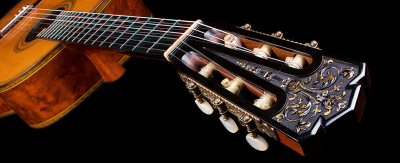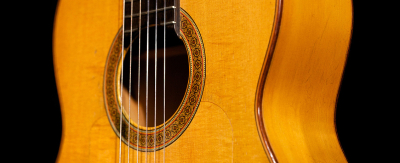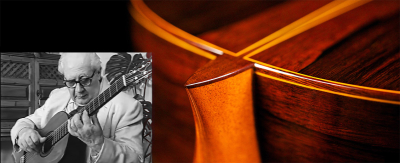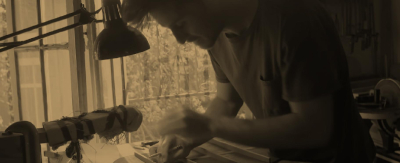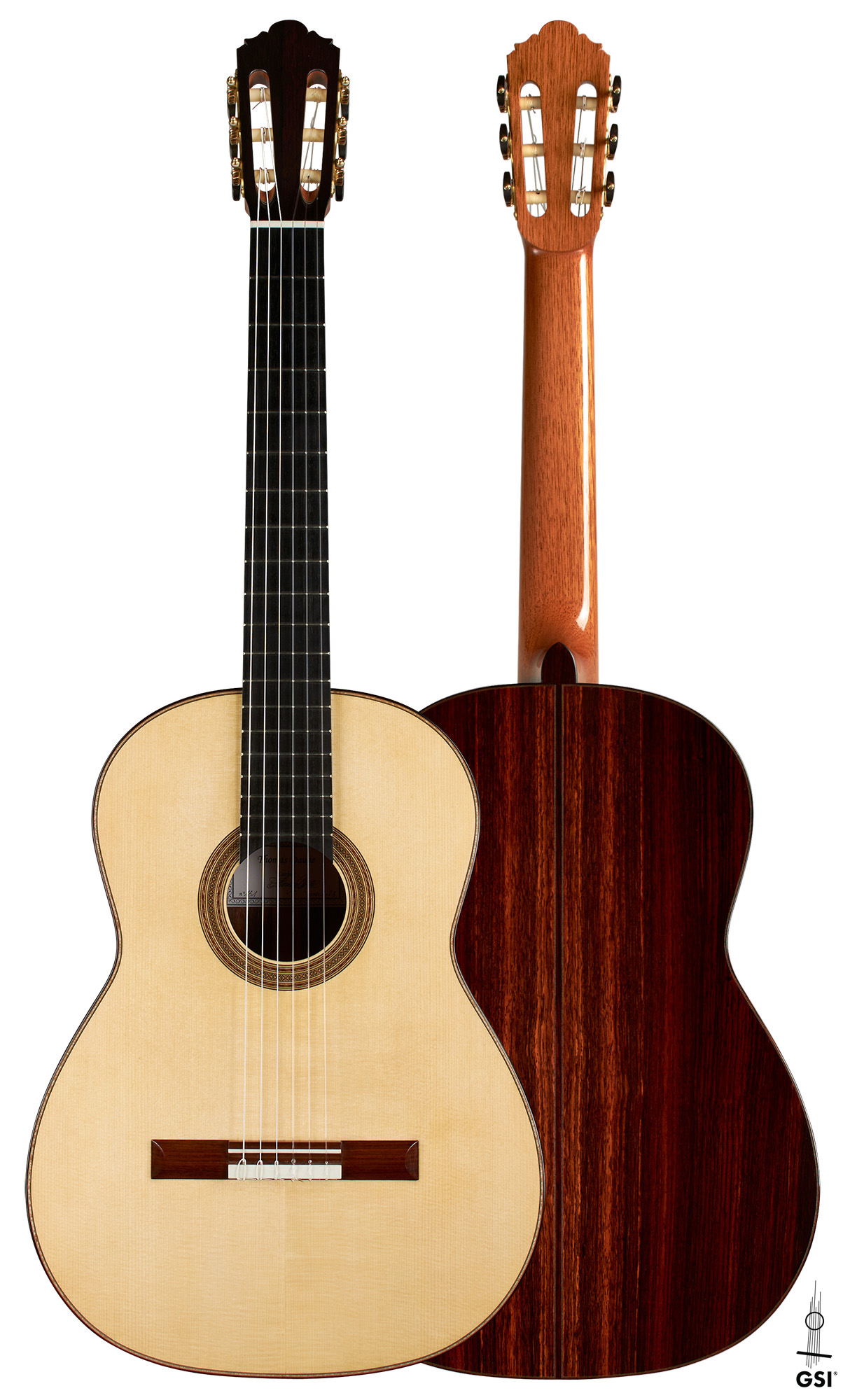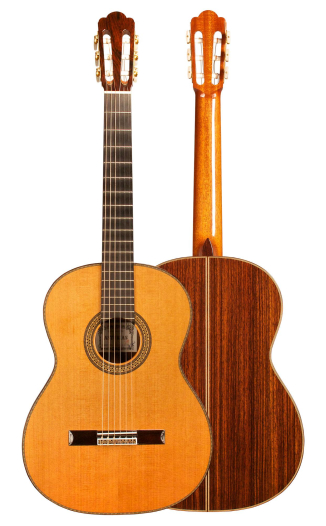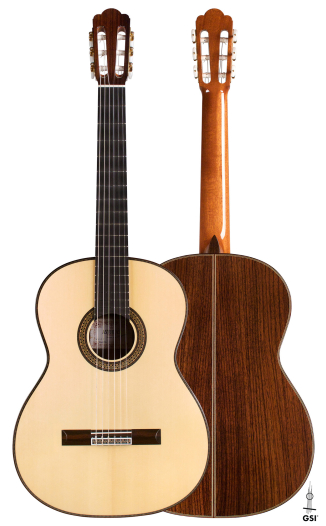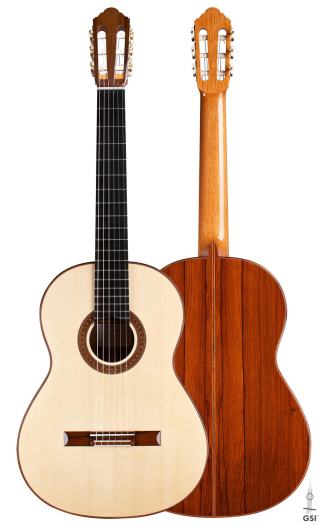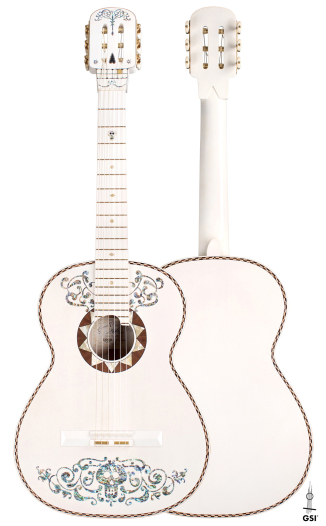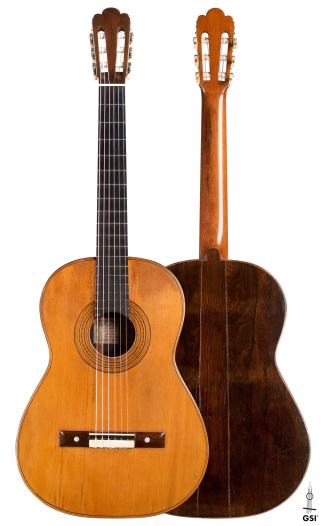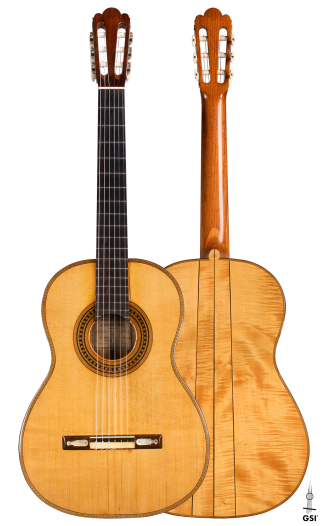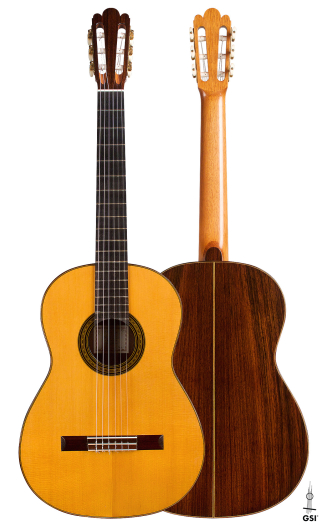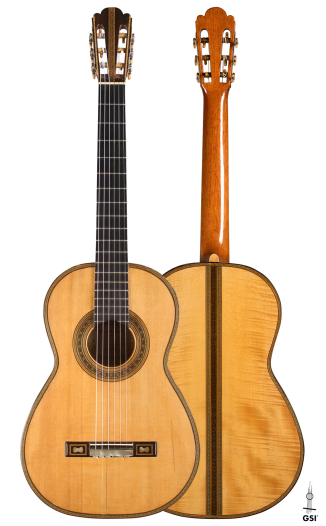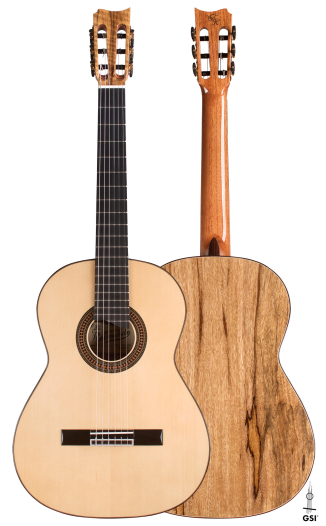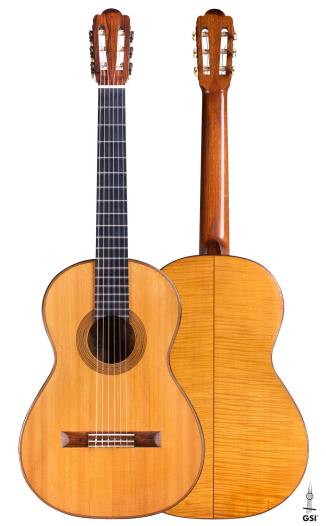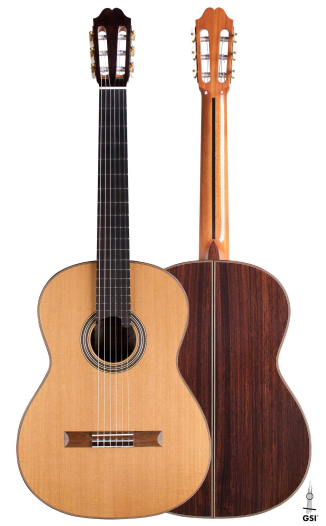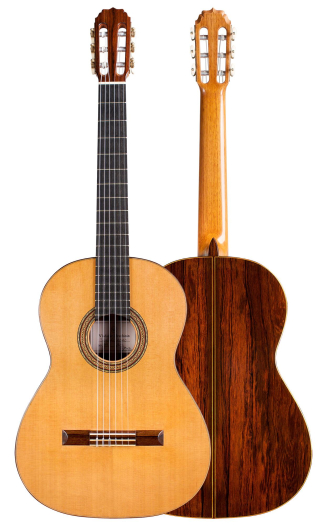2023 Thomas Dauge SP/IN
| Year | 2023 |
| Top | Spruce |
| Back & Sides | Indian Rosewood |
| Scale Length | 650 mm |
| Nut width | 52 mm |
| Finish | French Polish |
| Country | France |
| Condition | New |
| Exchange | ExchangePlus |
$14,000.00
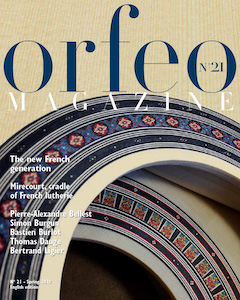 This beatiful instrument was built by French luthier Thomas Dauge, who works in the Bordeaux region of southwest France. This guitar combines aspects of the old Spanish masters (who inspired the beginning of Thomas' guitarmaking journey) with several elements that have now come to define the French school, especially the younger generation. In particular, this guitar has a sturdier/stiffer (and slightly heavier) box which is achieved by adding a series of mahogany strips along the interior of the sides (similar to Dominique Field's approach), as well as by using 3 tall horizontal back braces and two longitudal braces in additon to a wide and thick center brace. One immediate effect of this design is to distribute more of the vibrating surface of the guitar directly to the soundboard, which both improves volume and influences the character of the sound. Another interesting detail is that Thomas (like Daniel Friederich) has moved the bridge proportionally closer to the soundhole. This allows him to place the 12th fret a few millimeters above the neck-to-body joint for noticeably improved playability in that part of the neck, as well making enought space on the fingerboard for a full 19th fret under all 6 strings. This bridge placement is supported by Thomas' bracing system - a modified 7 fan system with his take on the Spanish-stye "treble stiffener" - instead of just one slanted brace below the lower harmonic bar, there is an additional brace below the 3 treble fans, shortening their lengths from both ends.
This beatiful instrument was built by French luthier Thomas Dauge, who works in the Bordeaux region of southwest France. This guitar combines aspects of the old Spanish masters (who inspired the beginning of Thomas' guitarmaking journey) with several elements that have now come to define the French school, especially the younger generation. In particular, this guitar has a sturdier/stiffer (and slightly heavier) box which is achieved by adding a series of mahogany strips along the interior of the sides (similar to Dominique Field's approach), as well as by using 3 tall horizontal back braces and two longitudal braces in additon to a wide and thick center brace. One immediate effect of this design is to distribute more of the vibrating surface of the guitar directly to the soundboard, which both improves volume and influences the character of the sound. Another interesting detail is that Thomas (like Daniel Friederich) has moved the bridge proportionally closer to the soundhole. This allows him to place the 12th fret a few millimeters above the neck-to-body joint for noticeably improved playability in that part of the neck, as well making enought space on the fingerboard for a full 19th fret under all 6 strings. This bridge placement is supported by Thomas' bracing system - a modified 7 fan system with his take on the Spanish-stye "treble stiffener" - instead of just one slanted brace below the lower harmonic bar, there is an additional brace below the 3 treble fans, shortening their lengths from both ends.
The resulting sound quality is absolutely amazing - it has a big (almost "husky"), overtone-rich firmness in every note. Rather than producing partials that scatter uncontrollably and "blur out" the fundamental of each note, the overtone content is packed densely and evenly within every note across the register, retaining great clarity to each fundamental. This hearty and thick sound makes playing legato a breeze thanks to the excellent sustain and clear separation. For those players who like a heftier D-shaped neck, this guitar fits the left hand like a glove. The right hand will be happy as well - the guitar has great dynamic range and responds beautifully to the slightest of adjustments in hand position and attack. Sound- and playability-wise, this is a strong concert guitar that could be played in any professional setting, whether in solo or ensemble in any venue regardless of size. On top of all this, it is meticulously built with great class and style from well-selected and cut materials. This is overall a guitar that combines great lyrical beauty with a big, robust sound to satisfy the needs of any modern concert and recording artist.
 This beatiful instrument was built by French luthier Thomas Dauge, who works in the Bordeaux region of southwest France. This guitar combines aspects of the old Spanish masters (who inspired the beginning of Thomas' guitarmaking journey) with several elements that have now come to define the French school, especially the younger generation. In particular, this guitar has a sturdier/stiffer (and slightly heavier) box which is achieved by adding a series of mahogany strips along the interior of the sides (similar to Dominique Field's approach), as well as by using 3 tall horizontal back braces and two longitudal braces in additon to a wide and thick center brace. One immediate effect of this design is to distribute more of the vibrating surface of the guitar directly to the soundboard, which both improves volume and influences the character of the sound. Another interesting detail is that Thomas (like Daniel Friederich) has moved the bridge proportionally closer to the soundhole. This allows him to place the 12th fret a few millimeters above the neck-to-body joint for noticeably improved playability in that part of the neck, as well making enought space on the fingerboard for a full 19th fret under all 6 strings. This bridge placement is supported by Thomas' bracing system - a modified 7 fan system with his take on the Spanish-stye "treble stiffener" - instead of just one slanted brace below the lower harmonic bar, there is an additional brace below the 3 treble fans, shortening their lengths from both ends.
This beatiful instrument was built by French luthier Thomas Dauge, who works in the Bordeaux region of southwest France. This guitar combines aspects of the old Spanish masters (who inspired the beginning of Thomas' guitarmaking journey) with several elements that have now come to define the French school, especially the younger generation. In particular, this guitar has a sturdier/stiffer (and slightly heavier) box which is achieved by adding a series of mahogany strips along the interior of the sides (similar to Dominique Field's approach), as well as by using 3 tall horizontal back braces and two longitudal braces in additon to a wide and thick center brace. One immediate effect of this design is to distribute more of the vibrating surface of the guitar directly to the soundboard, which both improves volume and influences the character of the sound. Another interesting detail is that Thomas (like Daniel Friederich) has moved the bridge proportionally closer to the soundhole. This allows him to place the 12th fret a few millimeters above the neck-to-body joint for noticeably improved playability in that part of the neck, as well making enought space on the fingerboard for a full 19th fret under all 6 strings. This bridge placement is supported by Thomas' bracing system - a modified 7 fan system with his take on the Spanish-stye "treble stiffener" - instead of just one slanted brace below the lower harmonic bar, there is an additional brace below the 3 treble fans, shortening their lengths from both ends.
The resulting sound quality is absolutely amazing - it has a big (almost "husky"), overtone-rich firmness in every note. Rather than producing partials that scatter uncontrollably and "blur out" the fundamental of each note, the overtone content is packed densely and evenly within every note across the register, retaining great clarity to each fundamental. This hearty and thick sound makes playing legato a breeze thanks to the excellent sustain and clear separation. For those players who like a heftier D-shaped neck, this guitar fits the left hand like a glove. The right hand will be happy as well - the guitar has great dynamic range and responds beautifully to the slightest of adjustments in hand position and attack. Sound- and playability-wise, this is a strong concert guitar that could be played in any professional setting, whether in solo or ensemble in any venue regardless of size. On top of all this, it is meticulously built with great class and style from well-selected and cut materials. This is overall a guitar that combines great lyrical beauty with a big, robust sound to satisfy the needs of any modern concert and recording artist.
Thomas Dauge was born in 1979 in Libourne, a small town in the Bordeaux region situated in the south west of France. As a teenager he became passionate about music and guitar in particular. In 1998 he began building his own instruments. His first attempts were folk and gypsy jazz guitars, but very quickly he moved towards the construction of classical and flamenco guitars. As he continued, he became he eventually decided to specialize exclusively in classical guitars. He opened his workshop in 2006 after 8 years of self-taught classical guitar making, but during these years he studied in depth the work of Daniel Friederich in the musical acoustics laboratory in Paris. His first instruments were essentially Spanish-inspired (Torres, Santos Hernandez, Miguel Rodriguez) but he eventually worked towards a more "personal" style influenced by developments pioneered by the French school. Although now he is undoubtedly part of the new generation of French makers, he continues to implement much of his earlier experience and knowledge of the old Spanish masters that he admires so greatly. The fusion between these two worlds gives his guitars a unique place in current international guitar making.
Thomas cites his experience in restoration work as having had a deep influence on his style. He has carried out repair work on guitars by many historically imporant luthiers (including instruments by Daniel Friederich, Ignacio Fleta, Manuel Ramirez, Miguel Rodriguez, etc.), making technical records of each guitar for his personal analysis. This has reinforced both his conviction of the universals of proper guitar making as well as understanding how the unique particulars of each maker contributes to the expression of their own personal style.
Thomas has extensive expertise in the knowledge of woods and he chooses them with the greatest meticulousness, according to criteria of cut, density, flexibility and texture and adapts the flexibility of the bracing to the soundboard. According to him, one of the essential points is good management of the structural stresses imposed on the soundboard. Records made of various measurements and their results has allowed him to empirically develop his style towards a very personal sound, the main goals being to provide maximum musicality, balance, sustain and polyphonic separation.
Thomas appreciates the importance of artistic and musical exchanges with guitarists. For him, it is an essential element in the development as a luthier and he counts among his clients many professional players, including concert artists Fernando Millet and Aurélien Colas.
Feel free to contact us with any questions. It’s what we’re here for!

